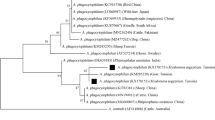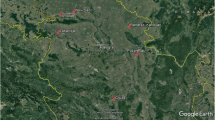Abstract
Anaplasma phagocytophilum is an obligate intracellular bacterium, circulating in the natural foci in enzootic, vector-host cycle. In Europe, A. phagocytophilum is transmitted by Ixodes ricinus ticks. In Slovakia, cervids which are considered as naturally infected reservoirs of A. phagocytophilum are besides the ticks commonly infested with insects from the family Hippoboscidae. In this study, the presence of A. phagocytophilum was confirmed in deer keds (Lipoptena cervi) removed from deer by using of molecular approach. Detection of A. phagocytophilum in deer keds represents the remains of infected blood meal taken from infected deer host, what underlines the potential role of these blood-sucking insects in the mechanical transmission of pathogenic bacteria within the susceptible population of wild animals. Moreover, it may suggest the risk for the transmission of A. phagocytophilum or related pathogens to humans and healthy animals via the bite of infected hematophagous ectoparasites.
Similar content being viewed by others
References
Altschul S.F., Madden T.L., Schäffer A.A., Zhang J., Zhang Z., Miller W. & Lipman D.J. 1997. Gapped BLAST and PSI-BLAST: a new generation of protein database search programs. Nucleic Acids Res. 25(17): 3389–3402. DOI: 10.1093/nar/25.17.3389
Bequaert J. 1939. Hippoboscid flies from North American doves. Science 89(2308): 267–268. DOI: 10.1126/science.89.2308.267-a
Bequaert J.C. 1953. The hippoboscidae or louse-flies (Diptera) of mammals and birds. Part 1. Structure, physiology and natural history. Entomol. Am. 32 n.s.: 201–209.
Blanco J.R., Oteo J.A. 2002. Human granulocytic ehrlichiosis in Europe. Clin Microbiol. Infect. 8(12): 763–72. DOI: 10.1046/j.1469-0691.2002.00557.x
Böe R. & Petersen K. 1991. Lipoptena cervi (Diptera), a potential vector of Megatrypanum trypanosomes of deer (Cervidae). Parasitol. Res. 77(8): 723–725. DOI: 10.1007/BF0092 8691
De La Fuente J., Naranjo V., Ruiz-Fons F., Höfle U., Fernández De Mera I.G., Villanúa D., Almazán C., Torina A., Caracappa S., Kocan K.M. & Gortázar C. 2005. Potential vertebrate reservoir hosts and invertebrate vectors of Anaplasma marginale and A. phagocytophilum in Central Spain. Vector Borne Zoonot. Dis. 5(4): 390–401. DOI: 10.1089/vbz.2005.5.390
De la Fuente J., Ruiz-Fons F., Naranjo V., Torina A., Rodríguez O. & Gortázar C. 2008. Evidence of Anaplasma infections in European roe deer (Capreolus capreolus) from southern Spain. Res. Vet. Sci. 84(3): 382–386. DOI: 10.1016/j.rvsc.2007.05.018
Dehio C., Sauder U. & Hiestand R. 2004. Isolation of Bartonella schoenbuchensis from Lipoptena cervi, a bloodsucking arthropod causing deer ked dermatitis. J. Clin. Microbiol. 42(11): 5320–5323. DOI: 10.1128/JCM.42.11.5320-5323.2004
Dumler J.S., Barbet A.F., Bekker C.P., Dasch G.A., Palmer G.H., Ray S.C., Rikihisa Y. & Rurangirwa F.R. 2001. Reorganization of genera in the families Rickettsiaceae and Anaplasmataceae in the order Rickettsiales: unification of some species of Ehrlichia with Anaplasma, Cowdria with Ehrlichia and Ehrlichia with Neorickettsia, descriptions of six new species combinations and designation of Ehrlichia equi and ‘HGE agent’ as subjective synonyms of Ehrlichia phagocytophila. Int. J. Syst. Evol. Microbiol. 51(6): 2145–2165.
Guy E.C. & Stanek G. 1991. Detection of Borrelia burgdorferi in patients with Lyme disease by the polymerase chain reaction. J. Clin. Pathol. 44(7): 610–621.
Haarlov N. 1964. Life cycle and distribution pattern of Lipoptena cervi (L.) (Dipt., Hippobosc.) on Danish deer. Oikos 15(1): 93–129.
Hackman W., Rantanen T. & Vuojolahti P. 1983. Immigration of Lipoptena cervi (Diptera, Hippoboscidae) in Finland, with notes on its biology and medical significance. Notulae Entomologicae 63: 53–59.
Haigh J.C., Mackintosh C. & Griffin F. 2002. Viral, parasitic and prion diseases of farmed deer and bison. Rev. Sci. Tech. IOE. 21(2): 219–248.
Halos L., Jamal T., Maillard R., Girard B., Guillot J., Chomel B., Vayssier-Taussat M. & Boulouis H.J. 2004. Role of Hippoboscidae flies as potential vectors of Bartonella spp. infecting wild and domestic ruminants. Appl. Environ. Microbiol. 70(10): 6302–6305. DOI: 10.1128/AEM.70.10.6302-6305.2004
Hawkins J.A., Love J.N. & Hidalgo R.J. 1982. Mechanical transmission of anaplasmosis by tabanids (Diptera: Tabanidae). Am. J. Vet. Res. 43(4): 732–734.
Chen S.M., Dumler, J.S., Bakken, J.S. & Walker, D.H. 1994. Identification of a granulocytotropic Ehrlichia species as the etiologic agent of human disease. J. Clin. Microbiol. 32(3): 589–595.
Kaunisto S., Kortet R., Härkönen L., Härkönen S., Ylönen H. & Laaksonen S. 2009. New bedding site examination-based method to analyse deer ked (Lipoptena cervi) infection in cervids. Parasitol. Res. 104: 919–925. DOI: 10.1007/s00436-008-1273-0
Kawahara M., Rikihisa Y., Lin Q., Isogai E., Tahara K., Itagaki A., Hiramitsu Y. & Tajima T. 2006. Novel genetic variants of Anaplasma phagocytophilum, Anaplasma bovis, Anaplasma centrale, and a novel Ehrlichia sp. in wild deer and ticks on two major islands in Japan. Appl. Environ. Microbiol. 72(2): 1102–1109. DOI: 10.1128/AEM.72.2.1102-1109.2006
Kocianová E., Kost’anová Z., Stefanidesová K., Spitalská E., Boldis V., Hucková D., Stanek G. 2008. Serologic evidence of Anaplasma phagocytophilum infections in patients with a history of tick bite in central Slovakia. Wien. Klin. Wochenschr. 120(13–14): 427–431. DOI: 10.1007/s00508-008-1000-y
Kocan K.M., de la Fuente J., Blouin E.F. & Garcia-Garcia, J.C. 2004. Anaplasma marginale (Rickettsiales: Anaplasmataceae): recent advances in defining host-pathogen adaptations of a tick-borne rickettsia. Parasitology 129(Suppl.): 285–300. DOI: 10.1017/S0031182003004700
Kočišová A., Lazar P., Letková V. & Goldová J. 2007. The species composition of the blood sucking Diptera (Tabanidae, Simuliidae) and Pupipara in deer breeding farm in East Slovakia. pp. 21–22. In: Janicki Z. (ed.), Book of Abstracts of the 2nd International Symposium “Game and Ecology”, Zagreb. Plitvice Lakes, October 17th to October 20th. ISBN: 978-953-6062-61-4
Kortet R., Harkonen L., Hokkanen P., Harkonen S., Kaitala A., Kaunisto S., Laaksonen S., Kekalainen J. & Ylonen H. 2010. Experiments on the ectoparasitic deer ked that often attacks humans; preferences for body parts, colour and temperature. Bull. Entomol. Res. 100: 279–285. DOI: 10.1017/S0007485309990277
Lane R.S., Mun J., Parker J.M. & White M. 2005. Columbian black-tailed deer (Odocoileus hemionus columbianus) as hosts for Borrelia spp. in northern California. J. Wildl. Dis. 41(1): 115–125.
Liz J.S., Sumner J.W., Pfister K. & Brossard M. 2002. PCR detection and serological evidence of granulocytic ehrlichial infection in roe deer (Capreolus capreolus) and chamois (Rupicapra rupicapra). J. Clin. Microbiol. 40(3): 892–897. DOI: 10.1128/JCM.40.3.892-897.2002
Lotric-Furlan S., Petrovec M., Avsic-Zupanc T., Nicholson W.L., Sumner J.W., Childs J.E. & Strle F. 1998. Human ehrlichiosis in central Europe. Wien. Klin. Wochenschr. 110(24): 894–897.
Nelson W.A. & Bainborough A.R. 1963. Development in sheep of resistance to the ked Melophagus ovinus (L.). III. Histopathology of sheep skin as a clue to the nature of resistance. Exp. Parasitol. 13: 118–127.
Nováková M., Víchová B., Majláthová V., Lesňáková A., Pochybová M. & PeŢko B. 2010. First case of human granulocytic anaplasmosis from Slovakia. Ann. Agric. Environ. Med. 17(1): 173–175.
Petrovec M., Bidovec A., Sumner J.W., Nicholson W.L., Childs J.E. & Avsic-Zupanc T. 2002. Infection with Anaplasma phagocytophila in cervids from Slovenia: evidence of two genotypic lineages. Wien. Klin. Wochenschr. 114(13-14): 641–647.
Petrovec M., Lotric Furlan S., Zupanc T.A., Strle F., Brouqui P., Roux V. & Dumler J.S. 1997. Human disease in Europe caused by a granulocytic Ehrlichia species. J. Clin. Microbiol. 35(6): 1556–1559. DOI: 10.1086/313948
Polin H., Hufnagl P., Haunschmid R., Gruber F. & Ladurner G. 2004. Molecular evidence of Anaplasma phagocytophilum in Ixodes ricinus ticks and wild animals in Austria. J. Clin. Microbiol. 42(5): 2285–2286. DOI: 10.1128/JCM.42.5.2285-2286.2004
Potgieter F.T., Sutherland B. & Biggs H.C. 1981. Attempts to transmit Anaplasma marginale with Hippobosca rufipes and Stomoxys calcitrans. Onderstepoort J. Vet. Res. 48: 119–122.
Rantanen T., Reunala T., Vuojolahti P. & Hackman W. 1982. Persistent pruritic papules from deer ked bites. Acta Derm. Venereol. 62(4): 307–311.
Reeves W.K., Nelder M.P., Cobb K.D. & Dasch G.A. 2006. Bartonella spp. in deer keds, Lipoptena mazamae (Diptera: Hippoboscidae), from Georgia and South Carolina, USA. J. Wildl. Dis. 42(2): 391–396.
Skoracki M., Michalik J., Skotarczak B., Rymaszewska A., Sikora B., Hofman T., Wodecka B. & Sawczuk M. 2006. First detection of Anaplasma phagocytophilum in quill mites (Acari: Syringophilidae) parasitizing passerine birds. Microbes Infect. Inst. Pasteur 8(2): 303–307. DOI: 10.1016/j.micinf.2005.06.029
Small R.W. 2005. A review of Melophagus ovinus (L.), the sheep ked. Vet. Parasitol. 130(1–2): 141–155. DOI: 10.1016/j.vetpar.2005.03.005
Smetanová K., Schwarzová K. & Kocianová E. 2006. Detection of Anaplasma phagocytophilum, Coxiella burnetii, Rickettsia spp., and Borrelia burgdorferi s. l. in ticks, and wild-living animals in western and middle Slovakia. Ann. N. Y. Acad. Sci. 1078: 312–315. DOI: 10.1196/annals.1374.058
Stuen S. 2007. Anaplasma phagocytophilum — the most widespread tick-borne infection in animals in Europe. Vet. Res. Commun. 7(Suppl. 1): 79–84. DOI: 10.1007/s11259-007-0071-y
Stuen S., Bergström K., Petrovec M., Van de Pol I. & Schouls L.M. 2003. DDifferences in clinical manifestations and hematological and serological responses after experimental infection with genetic variants of Anaplasma phagocytophilum in sheep. Clin. Diagn. Lab. Immunol. 10(4): 692–695. DOI: 10.1128/CDLI.10.4.692-695.2003
Štefanidesová E., Boldiš V., KošŢanov Kanka P., Nemethová D. & Špitalská E. 2008. Anaplasma phagocytophilum and Rickettsia helvetica infection in free-ranging ungulates in central Slovakia. Eur. J. Wildl. Res. 54(3): 519–524. DOI: 10.1007/s10344-007-0161-8
Telford S.R., 3rd. 1997. Risk for acquiring human granulocytic ehrlichiosis: exposure to deer blood or deer ticks? Clin. Infect. Dis. 24(3): 531–533.
Woldehiwet Z. 2006. Anaplasma phagocytophilum in ruminants in Europe. Ann. N.Y. Acad. Sci. 1078: 446–460. DOI: 10.1196/annals.1374.084
Zaugg J.L. & Coan M.E. 1986. Test of the sheep ked Melophagus ovinus (L) as a vector of Anaplasma ovis Lestoquard. Am. J. Vet. Res. 47(5): 1060–1062.
Author information
Authors and Affiliations
Corresponding author
Additional information
This work was presented during the Conference “Labudove dni 2011”
Rights and permissions
About this article
Cite this article
Víchová, B., Majláthová, V., Nováková, M. et al. PCR detection of re-emerging tick-borne pathogen, Anaplasma phagocytophilum, in deer ked (Lipoptena cervi) a blood-sucking ectoparasite of cervids. Biologia 66, 1082–1086 (2011). https://doi.org/10.2478/s11756-011-0123-1
Received:
Accepted:
Published:
Issue Date:
DOI: https://doi.org/10.2478/s11756-011-0123-1




